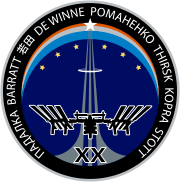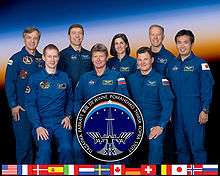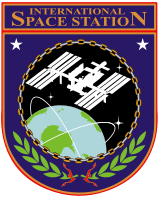Expedition 20
Expedition 20 was the 20th long-duration flight to the International Space Station. The expedition marked the first time a six-member crew inhabited the station. Because each Soyuz-TMA spacecraft could hold only three people, two separate launches were necessary: Soyuz TMA-14 launched on 26 March 2009, and Soyuz TMA-15 followed on 27 May 2009.[1]
| Mission type | ISS Expedition |
|---|---|
| Mission duration | 5 Months |
| Expedition | |
| Space Station | International Space Station |
| Began | 29 May 2009, 12:34 UTC[1] |
| Ended | 11 October 2009 |
| Arrived aboard | Exp 19/20: Soyuz TMA-14 Exp 20/21: Soyuz TMA-15 Wakata: STS-119 Space Shuttle Discovery Kopra: STS-127 Space Shuttle Endeavour Stott: STS-128 Space Shuttle Discovery |
| Departed aboard | Exp 19/20: Soyuz TMA-14 Exp 20/21: Soyuz TMA-15 Wakata: STS-127 Space Shuttle Endeavour Kopra: STS-128 Space Shuttle Discovery Stott: STS-129 Space Shuttle Atlantis |
| Crew | |
| Crew size | 8 |
| Members | Gennady Padalka* Michael Barratt* Koichi Wakata* (May–July) Timothy Kopra (July–August) Nicole Stott† (August–October) Frank De Winne† Roman Romanenko† Robert Thirsk† * – transferred from Expedition 19 † – transferred to Expedition 21 |
| EVAs | 2 |
| EVA duration | 5 hours, 6 minutes |
  Front Row: Frank De Winne, Gennady Padalka, Roman Romanenko Back Row: Robert Thirsk, Michael Barratt, Nicole Stott, Timothy Kopra, Koichi Wakata | |
Soyuz TMA-15 launched from Baikonur Cosmodrome at 10:34 UTC on 27 May 2009.[1] The vehicle docked with the station on 29 May 2009, officially changing the Soyuz TMA-14 crew from Expedition 19 to Expedition 20.[2]
Gennady Padalka was the first commander of a six-member station crew, and the first commander of two consecutive expeditions (Expedition 19 and 20). Nicole Stott was the final expedition astronaut to be launched on the shuttle.
During the expedition, Koichi Wakata performed a special experiment wherein he did not change his underpants for one month, in order to test a specially-designed underwear without washing or changing; he reportedly did not develop body odor due to the effects of the special garment.[3]
The station would not be permanently occupied by six crew members all year. For example, when the Expedition 20 crew (Roman Romanenko, Frank De Winne and Bob Thirsk) returned to Earth in November 2009, for a period of about two weeks only two crew members (Jeff Williams and Max Surayev) were aboard. This increased to five in early December, when Oleg Kotov, Timothy Creamer and Soichi Noguchi arrived on Soyuz TMA-17. It decreased to three when Williams and Surayev departed in March 2010, and finally returned to six in April 2010 with the arrival of Soyuz TMA-18, carrying Aleksandr Skvortsov, Mikhail Korniyenko and Tracy Caldwell Dyson.[4][5]
Crew
(May to July 2009) |
(July to August 2009) |
(August to October 2009) | |
|---|---|---|---|
| Commander | Third spaceflight | ||
| Flight Engineer 1 | First spaceflight | ||
| Flight Engineer 2 | Second and last spaceflight | ||
| Flight Engineer 3 | First spaceflight | ||
| Flight Engineer 4 | Second and last spaceflight | ||
| Flight Engineer 5 | Third spaceflight |
First spaceflight |
First spaceflight |
Backup crew






.svg.png)
Extra-vehicular activity
| Mission | Spacewalkers | Start (UTC) | End (UTC) | Duration |
|---|---|---|---|---|
| Expedition 20 EVA 1 ‡ |
Gennady Padalka Michael R. Barratt |
5 June 2009 7:52 |
5 June 2009 12:46 |
4 hours, 54 minutes |
| Prepared the Zvezda service module transfer compartment for the arrival of the Poisk module, installed docking antenna for the module, photographed antenna for evaluation on the ground, and photographed the Strela-2 crane.[7][8] | ||||
| Expedition 20 EVA 2 |
Gennady Padalka Michael R. Barratt |
10 June 2009 6:55 |
10 June 2009 7:07 |
12 minutes |
| Internal spacewalk in the depressurised Zvezda transfer compartment, to replace one of the Zvezda hatches with a docking cone, in preparation for the docking of the Poisk module later in 2009. Poisk docked automatically to the zenith port of Zvezda on 12 November 2009, and serves as an additional docking port for Russian vehicles.[9][10] | ||||
‡ denotes spacewalks performed from the Pirs docking compartment in Russian Orlan suits.
On 3 July 2009 expedition members undocked the Soyuz TMA-14 craft from the aft port of the Zvezda service module and piloted it over to the Pirs docking compartment. This was done to clear the way for the arrival of a Progress supply craft.[11]
- The Expedition 20 crew lands in Arkalyk, Kazakhstan


See also
References
![]()
- NASA HQ (24 May 2009). "Expedition 20 Crew Launches from Baikonur". NASA. Retrieved 4 June 2009.
- NASA HQ (29 May 2009). "Expedition 20 Crew Docks with Space Station". NASA. Retrieved 4 June 2009.
- "Astronaut wore pants for a month". BBC News. 31 July 2009. Retrieved 2 May 2010.
- "International Space Station Expeditions". NASA. 10 April 2009. Retrieved 13 April 2009.
- NASA (2008). "International Space Station". NASA. Retrieved 22 October 2008.
- NASA HQ (2008). "NASA Assigns Space Station Crews, Updates Expedition Numbering". NASA. Retrieved 21 November 2008.
- William Harwood for CBS News (5 June 2009). "Successful spacewalk ends". Spaceflightnow.com. Retrieved 5 June 2009.
- NASA (March 2009). "Expedition 20 Press Kit" (.pdf). NASA. Retrieved 4 June 2009.
- David Korth, Expedition 20 Spacewalk Flight Director (4 June 2009). "Expedition 20 Spacewalk Briefing Materials". NASA. Retrieved 10 June 2009.
- "Russian "Internal" Spacewalk Complete". NASA. 10 June 2009. Retrieved 6 July 2009.
- "Station Crew Completes Soyuz Move". spacefellowship.com. 3 July 2009. Retrieved 6 July 2009.
